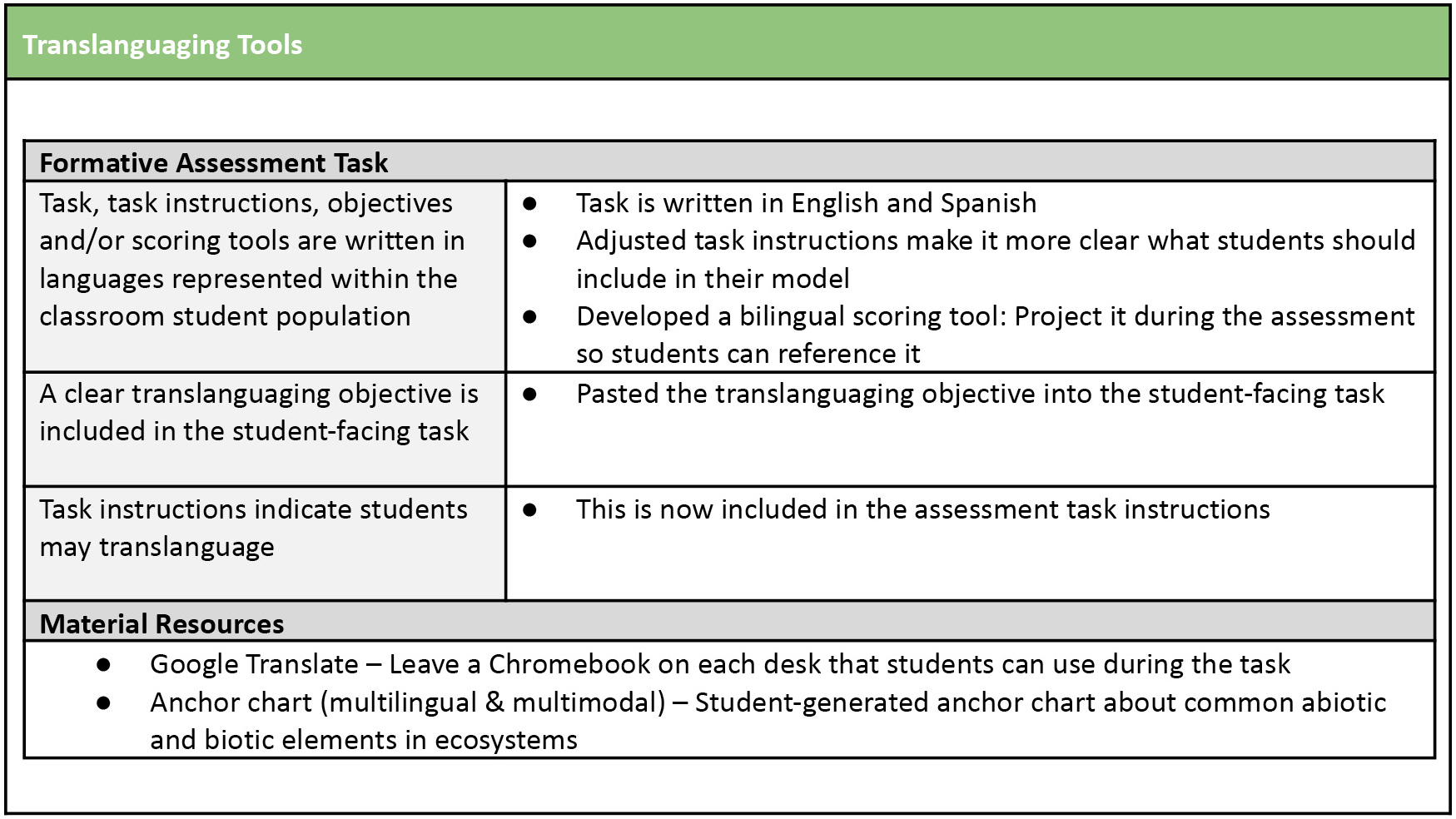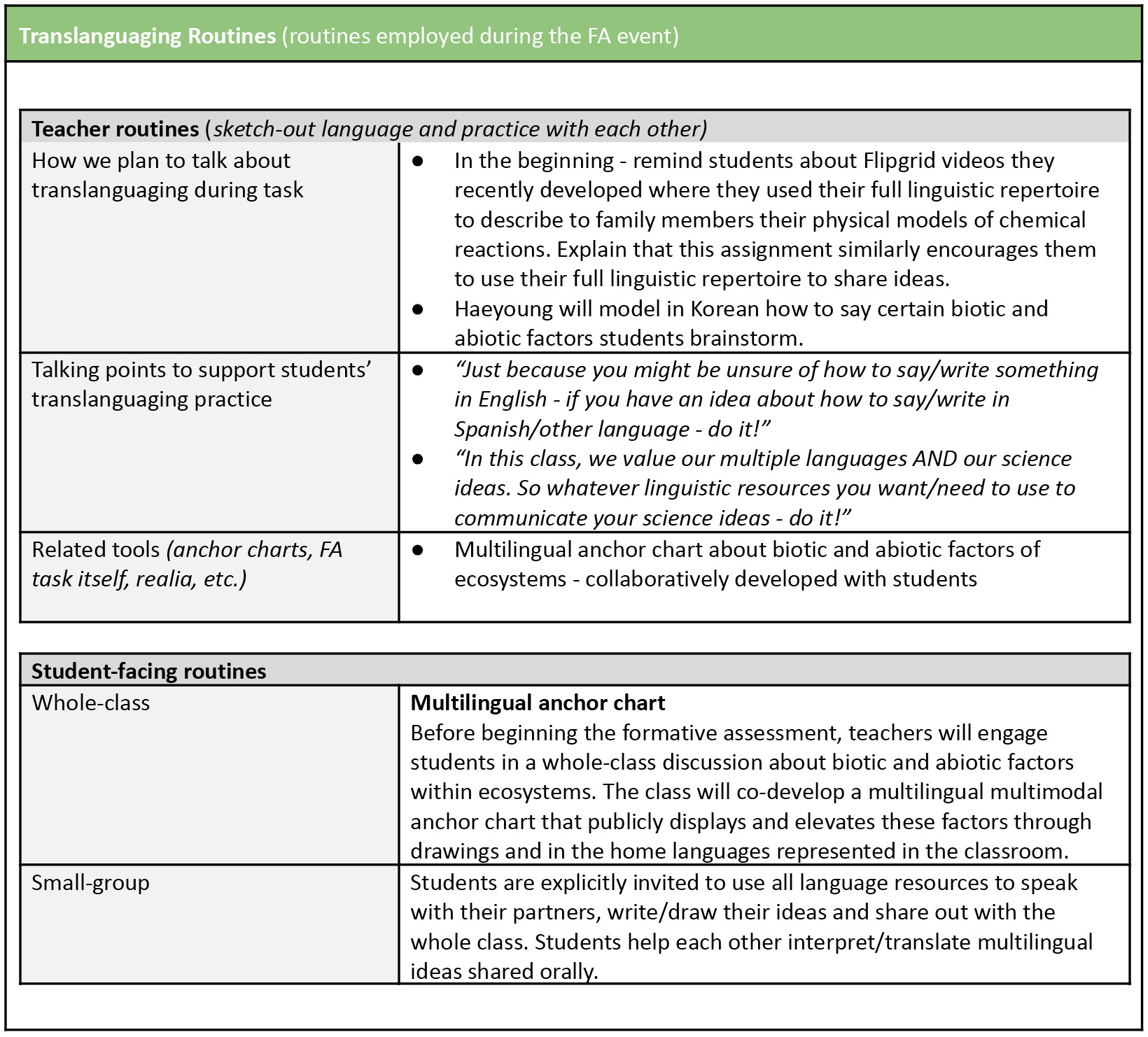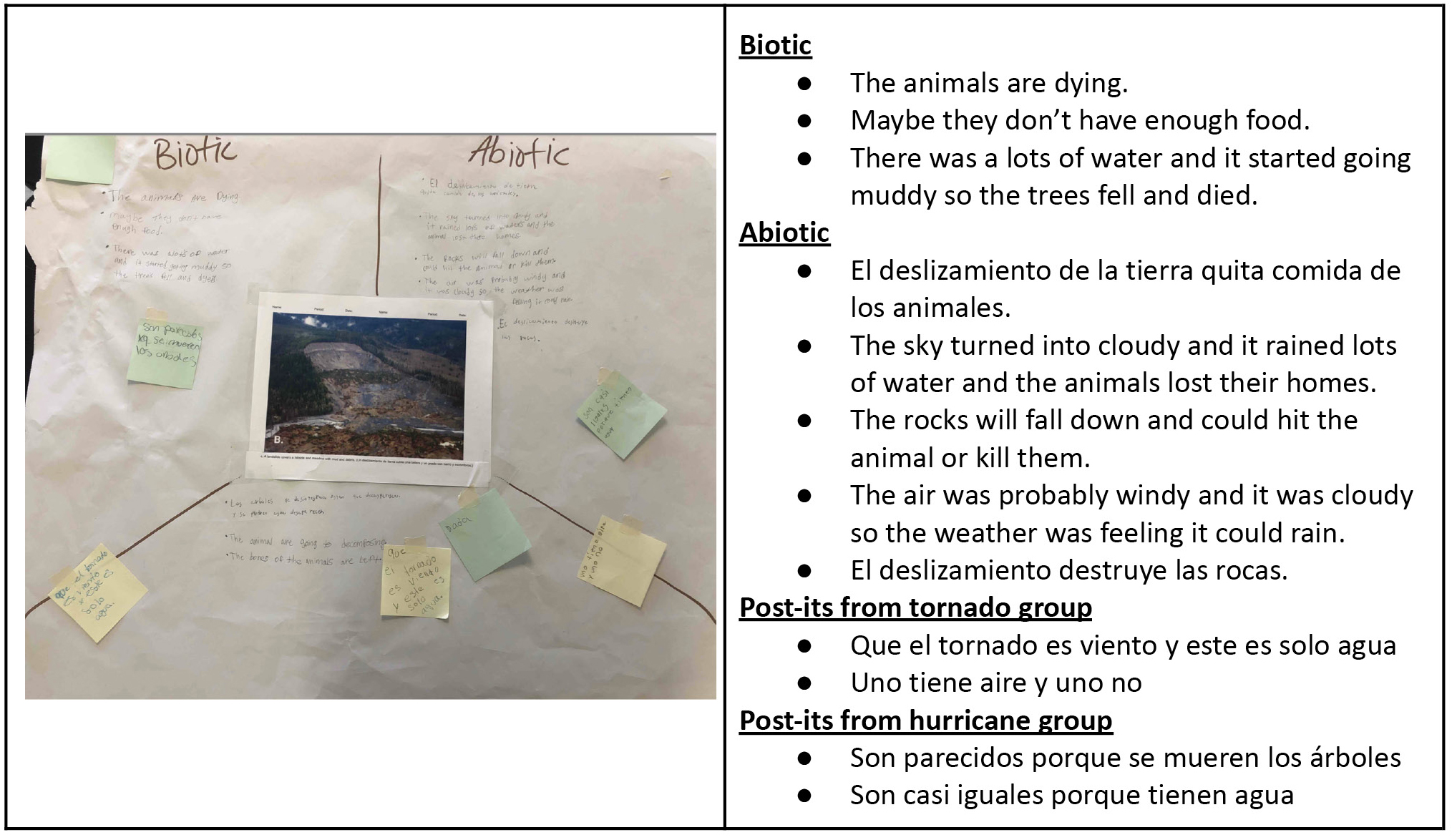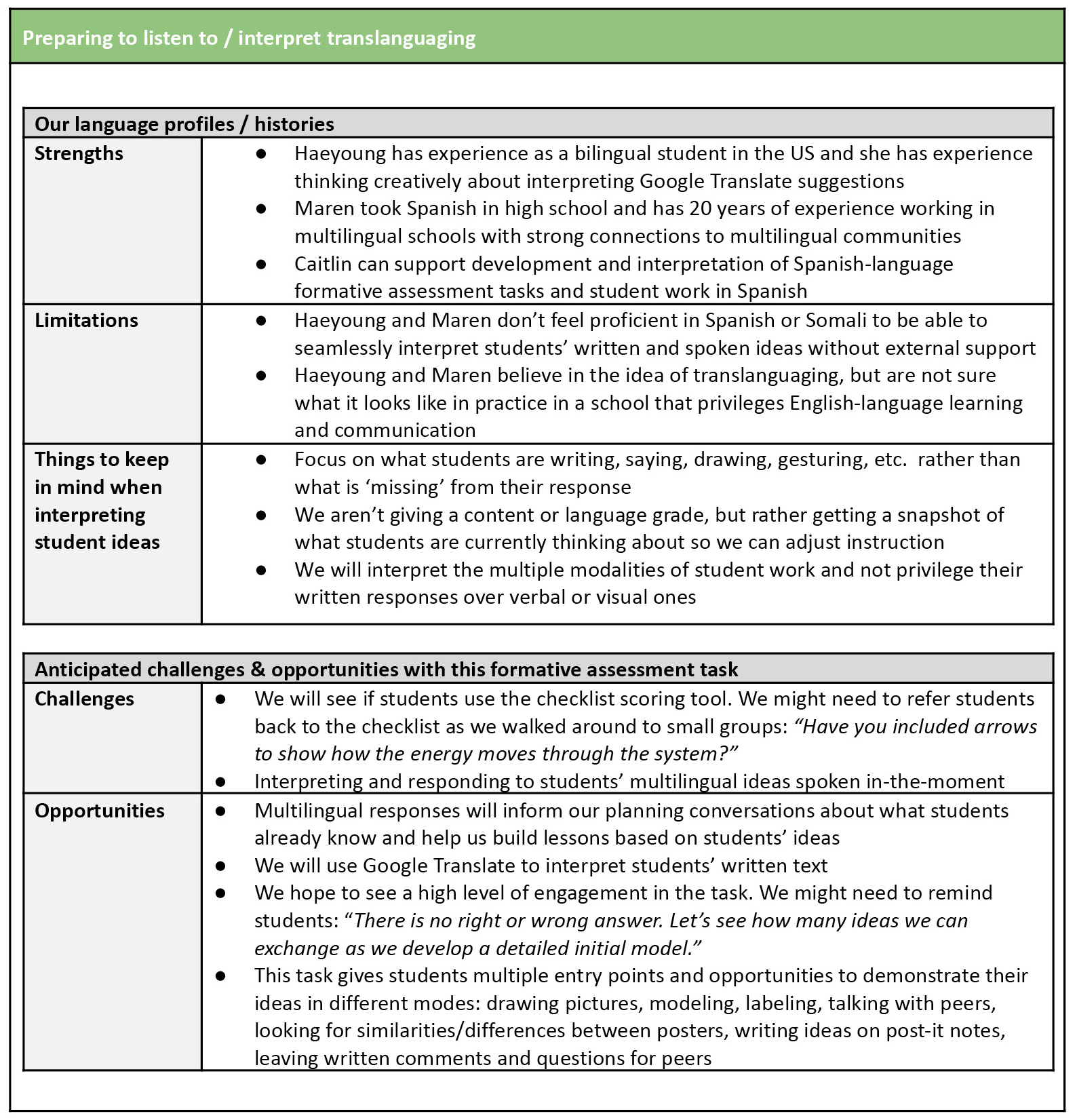feature
The (Trans)Formative Assessment Planning Template
Explicitly Welcome Translanguaging During Formative Assessment in Your Science Classroom
Science Scope—January/February 2023 (Volume 46, Issue 31)
By Caitlin Gailey McClearyCale Fine, Haeyoung Littich, and Maren Getz

Yo creo que el impacto del desgastamiento de tierra a un ecosistema es diferente que el impacto de un tornado porque el tornado tiene viento y el desgastamiento es solo agua. —Mario
Yes. Estoy de acuerdo. Also, they are parecidos because con los dos se mueren los árboles. —Isabel
These were comments students in Haeyoung’s and Maren’s classes made as they worked together on group posters about how natural disasters—such as landslides, droughts, and tornadoes—impact different ecosystems. These posters were part of a formative assessment task their sixth-grade students worked on collaboratively during their ecosystems unit to help Haeyoung and Maren understand their current sensemaking using all their language resources. The NGSS framework calls for teachers and curriculum designers to welcome students’ linguistic and cultural resources to expand classroom sensemaking opportunities, including assessment (National Research Council 2012; National Academies of Sciences, Engineering, and Medicine 2018). Although many teachers are on board with this idea, they find that they lack planning tools to support them as they develop and interpret multilingual formative assessment tasks. In this article, we share a tool that supports teachers in modifying or creating science formative assessment tasks for multilingual learners that welcome translanguaging.
What is formative assessment?
Formative assessment includes the formal and informal activities that allow teachers to get a sense of student ideas about a specific phenomenon or concept with the purpose of informing future instruction (Brookhart 2003). This can include formal, preplanned assessment tasks that are embedded within a unit of instruction. It can also include informal, in-the-moment questions or check-ins—such as ungraded exit tickets—that teachers use to get a sense of student thinking during classroom activities. For the purposes of this article, we focus on formal formative assessment activities that teachers prepare in advance.
Formative assessment is important in science because students’ ideas develop in nuanced and complex ways. An entire class of students rarely develops conceptual understanding about a topic along the same linear progression. This is particularly true in our increasingly heterogeneous classrooms across the United States, where students bring a variety of community-based and family-based experiences and linguistic resources.
Who are multilingual learners?
We use the term multilingual learners to describe a growing population of students in U.S. schools that includes students who are traditionally designated as English learners (ELs) or English language learners (ELLs) by the federal government. Additionally, our use of this term includes students who may be identified as “heritage speakers” or “sequential bilinguals,” meaning that they have grown up using to some degree two or more languages since birth. This reframing emphasizes the linguistic assets multilingual learners bring to science classrooms and elevates those assets as important tools that should be promoted to expand sensemaking opportunities (García and Kleifgen 2019; González-Howard, Andersen, and Pérez 2021).
The purpose of formative assessment is to get a snapshot of students’ ideas to adjust instruction. Given this, teachers should use formative assessment tasks that make space for all students, including multilingual learners, to demonstrate their conceptual understanding. One way to do this is through (trans)formative science assessment, described next.
(Trans)formative assessment in science
Translanguaging refers to the fluid interweaving of elements of multiple named languages, dialects, and/or registers for the purpose of communication (García and Wei 2014). It is the norm for bi/multilingual communities. For example, bilingual families might communicate orally in a combination of English and Spanish. In science classrooms, translanguaging has been observed as an important communication tool between bilingual teachers and their bilingual learners as well as between bilingual learners in small-group settings (Poza 2018). Increasingly, translanguaging is understood as including both linguistic and nonlinguistic modes, such as drawings and gestures (Sherris and Adami 2019). For example, multilingual learners use multimodal translanguaging during modeling tasks in science classrooms to deepen collective sensemaking around science content (Pierson, Clark, and Brady 2021).
Beyond integrating translanguaging into daily instruction, teachers should design for translanguaging in classroom assessment (Fine and Furtak 2020). However, little guidance exists about exactly how that might be accomplished (Fine 2022). The (trans)formative assessment development template tool supports teachers and assessment designers to design or modify tasks to support translanguaging. We iteratively developed this tool over one academic year as we engaged in multiple rounds of the (Trans)formative Assessment Co-Design (TAC) cycle (Fine 2022). Caitlin brought an initial version of the template to our teacher–researcher collaboration group. We modified and revised it after using it ourselves as a planning tool. The template has four main categories: expanding objectives, building from prior knowledge, welcoming translanguaging, and preparing to listen/interpret ideas.
The following section describes each category of the template and provides a concrete example of how we used it during a sixth-grade science unit focused on how natural disasters impact the biotic components of different ecosystems. The example is not meant to be prescriptive, but rather to show how the template might be used in practice. This article discusses the complete template, and a blank fillable template as well as a filled-out template are available online for download (see Supplemental Materials).
Expanding objectives
All teachers are language teachers, and for multilingual learners, every content-based assessment is also a language assessment (Mahoney 2017). As such, teachers should be clear from the start about an assessment’s content-specific objectives as well as multimodal translanguaging objectives and language-specific objectives (García, Johnson, and Seltzer 2017). By content-specific objectives, we mean the science objective(s) that the assessment aligns with. For example, for our formative assessment in the ecosystems unit, the content-specific objective was as follows: Students will be able to identify, model, and describe how physical disruptions affect the biotic components’ ability to get the energy and matter they need to live.
Multimodal translanguaging objectives refer to the ways students are encouraged to use linguistic and nonlinguistic modes to accomplish the assessment task. For example, a multimodal translanguaging objective might be: In this task, you are encouraged to use all your linguistic resources to discuss your ideas with a partner before drawing and labeling/writing them in your digital science notebook. Language-specific objectives are expectations of explicit ways students communicate their ideas through use of a named language, such as English. For example, a language-specific objective might be: In this task, you will use English to write one observation about the lab activity and one related phenomenon connected to the lab activity. In our ecosystem unit example, we decided there was no language-specific objective. We wanted to know what students thought through their full linguistic repertoire and drawings rather than what they could communicate using only written English.
Building from prior knowledge and interests
We know that students bring prior experiences and interests with them to science classrooms. These experiences and interests can inform and expand sense-making opportunities when noticed and leveraged by the teacher, or if they are overlooked or de-emphasized, sensemaking opportunities can become closed down (Haverly et al. 2020). When designing (trans)formative assessment tasks, teachers should pause to reflect about the community, family, and classroom-based experiences and interests that students bring to the formative assessment task. If teachers are unaware, they should check in with their students about their interests and experiences. This might be accomplished by creating space for students to share related phenomena during each science unit, by creating student interest surveys, or by making a point of genuinely getting to know students and the communities in which they live. Teachers should connect these experiences to the assessment itself.
For example, as we discussed modifications to the ecosystems assessment, Haeyoung and Maren shared that many students bring firsthand experience about the effects of drought, hail, and forest fires. They shared that many students were also interested in learning more about tornadoes that commonly threaten Colorado towns. Our modifications included adding drought, forest fires, and tornadoes to the assessment task based on knowledge of these prior experiences and interests. This reflection can also influence how teachers support students during the (trans)formative assessment task—helping them make connections they might not initially recognize as relevant. For example, Maren helped her newcomer students from Mexico make connections between avalanches, something few of her newcomer students were familiar with, and landslides, a natural disaster several of them had experienced firsthand. Finally, teachers should return to this planning template before interpreting student responses on formative assessment tasks. This is important because recentering students’ prior knowledge and interests before reviewing their work can support asset-oriented interpretations.
Welcoming translanguaging
Teachers can support translanguaging in their classrooms through specific tools and enactment routines.
Translanguaging tools
The formative assessment task itself as well as the task instructions and scoring rubrics or checklists should be written in languages represented within the classroom community and should explicitly indicate that students may translanguage in their responses (see Figure 1). Additionally, translated readings and student-facing worksheets should be available for students to use during the assessment. Finally, external material resources, such as bilingual dictionaries and internet-based translation apps, should be available to students.

Example of planning translanguaging tools in ecosystems unit.
We presented an individual think-time component of the ecosystems task in both English and Spanish and presented instructions in both languages side-by-side because the majority of Spanish-speaking students learned Spanish first and then English (see Figure 2). We included our translanguaging objective in the student-facing worksheet and made it explicit in the task instructions themselves that students could translanguage in their responses. We also developed a bilingual “gotta-have-it” checklist projected on the board so students knew the elements they might include in their model. Finally, we had Chromebooks with Google Translate easily accessible for students.

Example of individual student-facing worksheet completed before small-group poster activity.
Translanguaging routines
Translanguaging routines are the pedagogical moves teachers use before and during assessments as well as student routines built into assessment components.
Teacher routines
One pedagogical routine teachers should plan for is how they welcome students’ translanguaging practices at the beginning of the assessment event. For example, teachers might remind students about class norms that value contributions in all home languages as important for sensemaking. Additionally, teachers might model their own bilingualism as they think aloud about the assessment task or refer to a co-created multilingual anchor chart related to the assessment phenomena. If teachers are not bilingual/multilingual themselves, they can use translation apps and online dictionaries to communicate with students in their home languages. They can also make translation apps and online dictionaries available for multilingual students to use as needed to communicate ideas with classmates and teachers throughout the day. Furthermore, teachers should get “meta” with students about the power that English generally holds in U.S. classrooms. For example, teachers might explicitly talk with students about how their classroom is different from many because multilingualism is seen as a superpower that is important for sensemaking. These types of meta moves can help disrupt English-only views.
As we introduced the ecosystems formative assessment task, Haeyoung and Maren planned to connect to previous formative assessment activities where students had also translanguaged (see Figure 3). Finally, we circulated around the room while small groups worked together and continued to encourage students to share their ideas multilingually and multimodally, including on the group posters.

Example of planning translanguaging routines in ecosystems unit.
Student routines
Teachers also need to plan the collaborative routines students employ as they work through the assessment task. For example, teachers might plan for students to turn and talk with a language partner about their initial ideas using their full linguistic repertoire before writing their ideas in English. In our ecosystems task, we began with a whole-group activation activity where students co-developed a multilingual and multimodal anchor chart with examples of biotic and abiotic factors (e.g., insects, pine trees, air, sunlight). Additionally, we placed students in small groups strategically for the poster component to allow collaboration through translanguaging with language partners who shared common linguistic resources (see Figure 4 for an example of a group poster).

Example of a collaborative group poster from the landslide group.
Preparing to listen to/interpret ideas
Teachers should address their assumptions about language and communication as they develop (trans)formative assessment tasks. One way to do this is to pause during the assessment planning process to reflect on our own language ideologies and language profiles. Language ideologies refer to the ways our ideas about language and accent are informed by and reflect our socialization and ideas about people and society (Flores and Rosa 2015). For example, when multilingual learners orally share their ideas in English with a heavy accent, there is evidence that teachers often interpret those ideas as incorrect or less sophisticated than those of English-speaking peers (Lippi-Green 2012). In contrast to this deficit-oriented approach, it is important to value all ways students use language to communicate and engage in sensemaking. Language profiles refer to our individual linguistic histories and the language resources we use to communicate. Reflection work related to our linguistic ideologies and language profiles starts by reading and discussing practitioner-oriented blogs and readings and relating the content to our own histories as language users and interpreters (see Other Resources).
Additionally, this work includes anticipating opportunities and challenges teachers might face as they implement translanguaging tools and routines, given their linguistic profiles, histories, and ideologies (see Figure 5). For example, Maren was nervous about interpreting student ideas in the moment when students shared with her in languages other than English. She began to understand that sensemaking should center around students and their ideas, not teachers’ agendas or accountability frameworks. She became more comfortable interpreting students’ multilingual ideas with the help of colleagues, students, and technology resources and leaning into their multimodal representations as evidence of important nonlinguistic sensemaking:

Example of preparing to listen/interpret translanguaging in ecosystems unit.
They speak to me in Spanish, because they know I value whatever language that they want to use. And most of the time, I just nod. And the kids are like “Miss, you understand?” I get most of it. You can hear things and you understand that they are on topic and that they’re using the concepts. It’s just been fun to watch the kids trust me to tell me what they know. I’m just watching them become extremely comfortable and very confident learners. And they’ll just talk to me and I’ll figure it out.
Conclusion
The (trans)formative assessment template allowed us to be intentional about how we welcomed translanguaging and connected to students’ experiences as we planned modifications for pre-existing curricular tasks. The modified task allowed us to see engagement, excitement, and even joy from students who usually choose to remain passive observers of classroom activities. Additionally, students’ bilingual conversations and written text provided us a window into their current sensemaking. Teachers can use the template as an outline to guide formative assessment development from the beginning or as a tool while modifying existent formative assessments for use in classroom contexts with emergent multilingual learners. If you are interested in trying out the (trans)formative assessment template in your own practice, use the blank template in Supplemental Materials.
OTHER RESOURCES
Why a raciolinguistic perspective passes the classroom reality check (Fores 2019)—https://bit.ly/3B8w39o
The impact of language ideologies in schools. Educational Leadership (Fine, Strong, and Palmer 2020)—https://bit.ly/3P1SLFK
Translanguaging: A CUNY-NYSIEB guide for educators (Celic and Seltzer 2012)—https://bit.ly/3XXuUve
The translanguaging classroom (García, Ibarra-Johnson and Seltzer 2017)
SUPPLEMENTAL MATERIALS
Blank (Trans)Formative Assessment Development Template—https://bit.ly/3Yoe1Kn
Filled-out (Trans)Formative Assessment Development Template—https://bit.ly/3Ylxprv
Caitlin Gailey McClearyCale Fine (cfine5@msudenver.edu) is an assistant professor of elementary education at Metropolitan State University of Denver. Haeyoung Littich is a science teacher and Maren Getz is a science teacher, both at Aurora Public Schools in Aurora, Colorado.
Assessment English Language Learners Equity Inclusion Teaching Strategies Middle School


